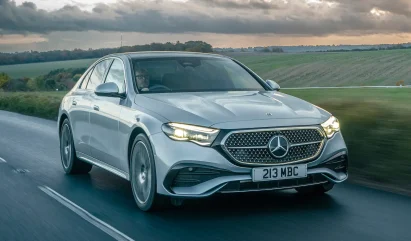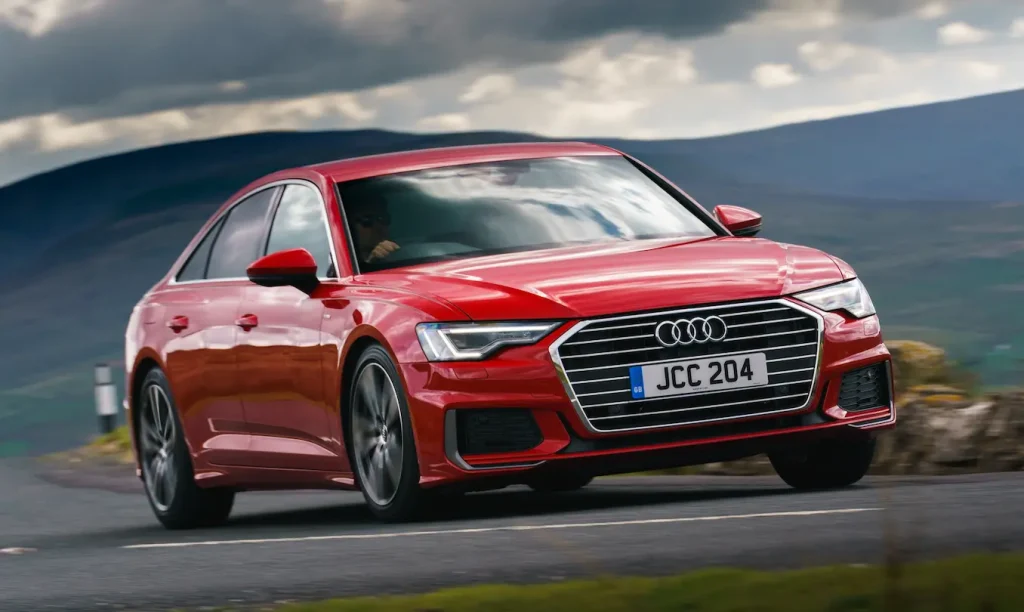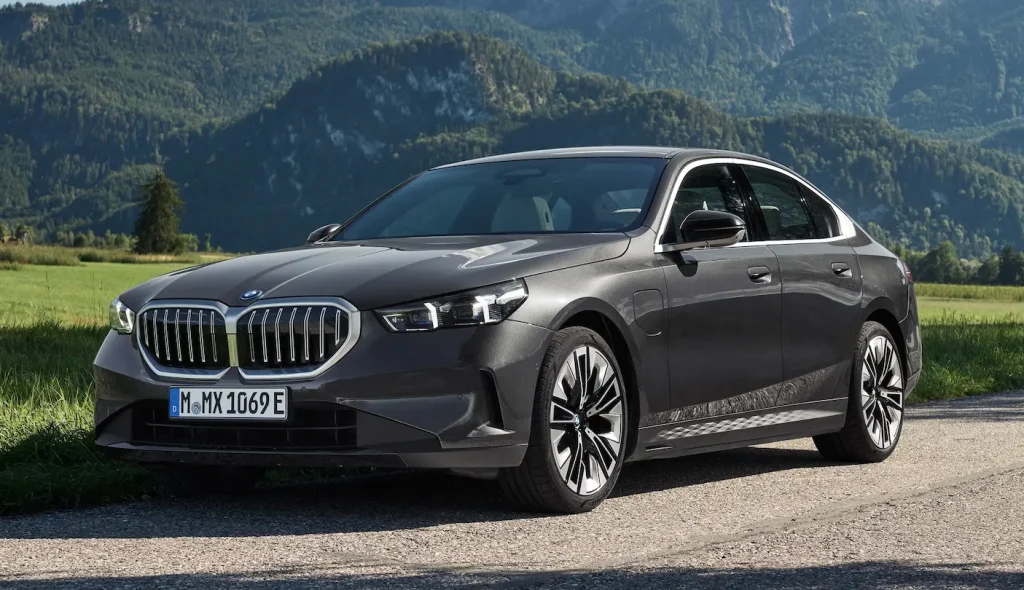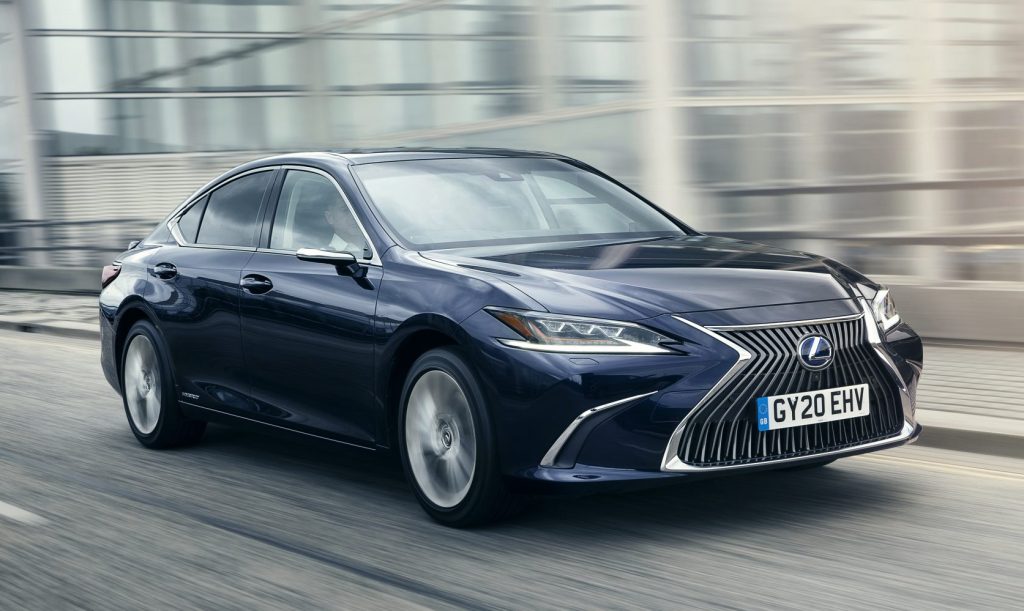
Mercedes-Benz E-Class
Highlights of the sixth-generation E-Class, according to Mercedes, are the more dynamic exterior, and latest generation of MBUX multimedia system, plus all are powered by mild hybrid or plug-in hybrid engines.
The influence of the bigger S-Class on the new E-Class’s styling is obvious, with the same high-waisted silhouette, plus pop-out door handles. However, we think the front and rear styling takes its lead from the EV EQ range.
The EQE and EQS show their influence on the inside with the curvy dashboard design. There is a 12.3in screen perched behind the steering wheel for the instruments, a large 14.4in infotainment touchscreen in the middle, and on AMG Line Premium spec, another 12.3in screen on the passenger side. Although, as we’ve found before when this screen is fitted, it is more of a gimmick than being of any real use. Rear passengers benefit from extra legroom thanks to the 22mm longer wheelbase. The most noticeable interior compromise of having the extra hybrid battery, is the drop in boot space (170 litres less than the previous E-Class generation). Although still useful, the boot now totals 370 litres.
Under the bonnet, the new E-Class is available with the choice of two diesel (E220 d, E400 d 4Matic), and two petrol engines (E200, E450 4Matic), plus, of most interest to fleet drivers, an EQ plug-in hybrid that we compare here (E300e).
The E300e is powered by a 204hp, 2.0-litre petrol turbo engine, combined with a 25.4kWh battery, equalling an impressive 313hp. But the performance figures aren’t what this E-Class is about. Company car drivers are going to be keener on the 5% BIK charge, 13g/km emissions, and up to a claimed 565mpg consumption.
The Mercedes has the best BIK figure, with the Audi and BMW at 8%, and the Lexus some way behind at 29%. The Mercedes has an official fuel economy figure of up to 565mpg, with the BMW next at 470.8mpg, The Lexus as a self-charging hybrid is a long way behind at 53.2mpg, with the rest plug-ins – although drivers without charger access will likely find this situation reversed in real-world use. There is more good news for the E300e when we talk about residual value, as at 42%, it’s the slowest depreciator of this group, with the BMW just behind, in second place with 41%.
At £70,845, the Mercedes has the highest P11D figure of this set, with the Audi not too far behind. However, the price is not enough to stop it coming top in terms of the cost per mile, with its 69.40p figure.
| Model | Mercedes E300e EQ Power AMG Line Premium |
| P11D | £70,845 |
| CO2 (tax) | 13g/km (5%) |
| BIK 20/40% a month | £59/£118 |
| Fuel consumption | 470.8 – 565mpg |
| National Insurance | £40.73 |
| First year VED | £0 |
| Subsequent VED | £590 |
| Engine size/power | 1,999cc/313hp |
| AFR | 16p |
| Residual value | 42% |
| Depreciation | £40,440 |
| Fuel costs | £810.36 |
| SMR | £3,960 |
| Cost per mile | 69.40p |

Audi A6
It might be one of the older members of this group, but the A6 still looks sharp – especially in Black Edition spec. It also scores highly for refinement, the spacious interior, and impressive level of quality throughout. On the road, this plug-in hybrid is still a keen performer – with a 0-60mph acceleration time of 6.2 seconds, yet it still has a full-electric range of 34 miles.
Also available with mild hybrid engines, the 2.0-litre TFSIe petrol is the only plug-in engine available. The result being the 32g/km CO2 figure and an 8% BIK implication.
Second most expensive to buy of our group, the A6 also has the highest SMR figure at £4,148. The Audi has the joint second lowest tax figure within this group, joining the BMW and Mercedes at 8%. Audi claim a 217.3mpg figure, this puts the A6 in third place, behind the BMW and Meredes. Perhaps showing its age, the A6 is the biggest depreciator at 42%, equalling a disappointing last place in the cost per mile figures.
| Model | Audi A6 50 TFSIe Quattro Black Edition Tech Pro |
| P11D | £69,820 |
| CO2 (tax) | 32g/km (8%) |
| BIK 20/40% a month | £93/£186 |
| Fuel consumption | 217.3mpg |
| National Insurance | £64.24 |
| First year VED | £0 |
| Subsequent VED | £590 |
| Engine size/power | 1,984cc/295hp |
| AFR | 16p |
| Residual value | 32% |
| Depreciation | £46,845 |
| Fuel costs | £810.36 |
| SMR | £4,148 |
| Cost per mile | 86.33p |

BMW 5 Series
The all-electric i5 might be getting all the attention, but BMW haven’t totally forgotten the combustion engine in the 5 Series, as this 530e is one of the three available. It is a plug-in hybrid, and boasts 56 miles of electric range.
Outside, the 5’s styling is toned down over the 7 Series, and the result is attractive and sleek with sharp detailing. This 5 suits the thorough de-chrome that’s standard on performance-orientated M Sport grades.
Rapid, grippy and fun sum up the drive, the steering is precise – but light, although there’s enough feedback. Handling is tight, with plenty of grip in corners.
As expected, the 530e’s closest rival in this set is the Mercedes. Although the BMW can’t match the E300e’s 5% BIK figure, and the 14g/km emissions are probably key to why, although claiming a strong second place, it is still some way behind the Mercedes.
| Model | BMW 530e M Sport (Tech Plus and Comfort Plus Packs) |
| P11D | £67,700 |
| CO2 (tax) | 14g/km (8%) |
| BIK 20/40% a month | £90/£180 |
| Fuel consumption | 470.8mpg |
| National Insurance | £62.28 |
| First year VED | £0 |
| Subsequent VED | £590 |
| Engine size/power | 1,998cc/295hp |
| AFR | 16p |
| Residual value | 41% |
| Depreciation | £39,450 |
| Fuel costs | £810.53 |
| SMR | £3,735 |
| Cost per mile | 73.32p |

Lexus ES
If you’re not sold on the idea of plugging in for running-cost savings, then the self-charging Lexus ES might be a better solution – as it can still travel for short distances on electric power alone.
Outside, the distinctive front grille means this Lexus couldn’t be mistaken for any other model. Inside, because we’re comparing the range-topping Takumi, there’s all the kit you’d need in the well-finished interior – including the impressive 17-speaker Mark Levinson Premium Surround Sound System with Pure Play, and a 360-degree Panoramic View Monitor. It’s spacious too, although the boot at 454 litres is on the small side – and the rear seat won’t fold.
The Lexus is in last place here because it has a much higher operating cost, as, according to our calculations, its fuel costs will be nine times more than the other cars here.
The Lexus also suffers with NI costs that are based on it being a 29% band car, which although closer to small-car figures, is a big difference from the 5% band of the Mercedes, and the joint 8% figure of the Audi and BMW. Still, the one thing in its favour, is that it has the cheapest P11D figure here by a margin at £56,630.
| Model | Lexus ES 300h Takumi |
| P11D | £56,630 |
| CO2 (tax) | 121g/km (29%) |
| BIK 20/40% a month | £273/£547 |
| Fuel consumption | 53.2mpg |
| National Insurance | £188.86 |
| First year VED | £210 |
| Subsequent VED | £590 |
| Engine size/power | 2,487cc/215hp |
| AFR | 26p |
| Residual value | 33% |
| Depreciation | £37,254 |
| Fuel costs | £7,173 |
| SMR | £3,031 |
| Cost per mile | 79.09p |





